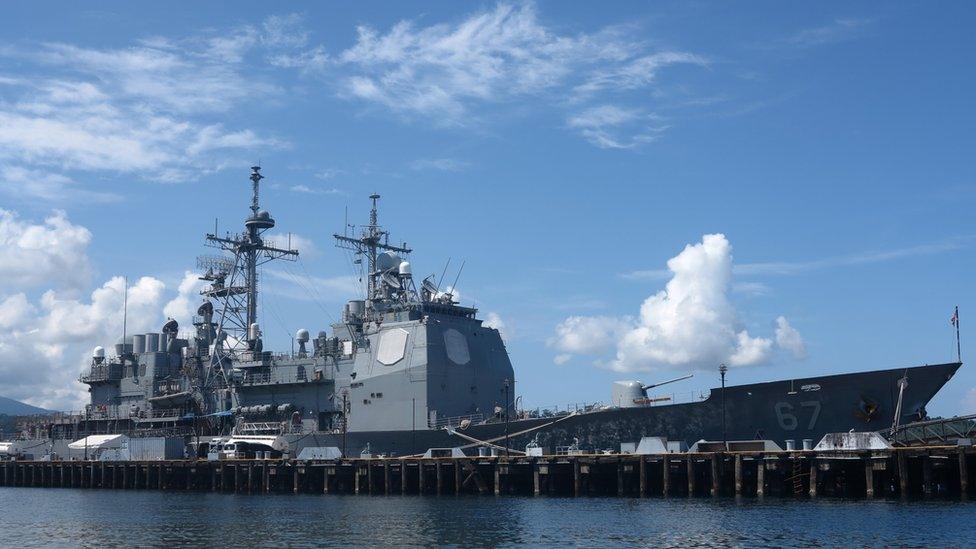South China Sea: What's China's plan for its 'Great Wall of Sand'?
- Published
In 2018, a BBC team flew over the disputed South China Sea islands in a US military plane
Despite all the other issues demanding China's attention this year - the virus, its trade war with the US, Hong Kong's national security law, and a host of economic woes - the South China Sea has been revived in recent months as an arena for serious tensions.
With US Secretary of State Mike Pompeo now - for the first time - calling China's territorial claims in the South China Sea unlawful, Alexander Neill examines China's plans to extend its reach in the region.

The South China Sea, home to vital shipping lanes, has been a flashpoint for years, with several countries claiming ownership of its small islands and reefs and with it, access to resources.
In recent years, China has been increasingly assertive over what it claims are its centuries-old claims to the contested region, and has been rapidly building up its military presence to back up those claims.
Former Commander of US Pacific Command, Admiral Harry Harris once referred to this as the "Great Wall of Sand" - a "nine-dash line" creating a protective ring and supply network around Chinese territory at sea, as the wall did on land.
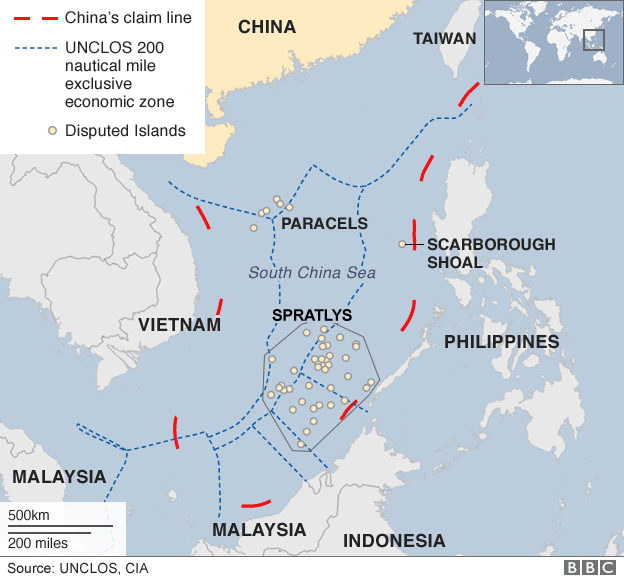
But while China and the US have traded increasingly barbed comments over the South China Sea, broadly speaking, they had managed such differences.
Despite their trade conflict, the US had avoided taking sides in China's territorial disputes with other countries - other than to demand freedom of movement for its vessels.
Then, the Covid-19 pandemic hit.
Criticism of China's early handling of the outbreak, led by the US, has enraged China.
Many Western leaders appear to be persuaded by Mr Pompeo's argument that China was exploiting the pandemic to double-down on its coercive behaviour in general.
And those rising tensions have been playing out in the South China Sea.
Military tensions at a worrying time
In early April, a Chinese Coast Guard vessel rammed and sank a Vietnamese fishing vessel close to the Paracel Islands, which China and Vietnam claim as theirs.
Then, a Malaysian oil exploration project also found its operations disrupted off the coast of Borneo by a Chinese marine survey vessel, the Haiyang Dizhi 8, backed by China's Navy and Coast Guard.
Consequently, the USS America, a US Navy amphibious assault ship, joined by an Australian frigate, was deployed to waters nearby.
The escalation continued with the deployment of two US Navy guided missile destroyers, USS Bunker Hill and USS Barry to the Paracel and Spratly Islands (known as the Xisha and Nansha in Chinese) respectively.
The warships conducted Freedom of Navigation Operations (FONOPs) aimed at challenging what the US views as a pattern of China's unlawful claims in international waters.
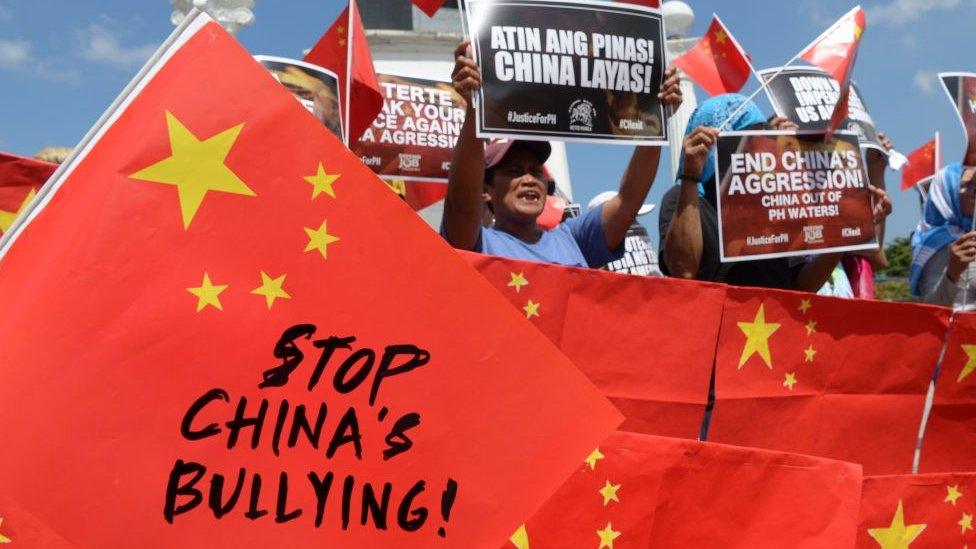
A 2019 protest in Manila in the Philippines against Chinese "aggression" in the South China Sea
Most recently, China closed off a swathe of sea space to conduct naval exercises in the waters surrounding the Paracel Islands. The US angrily said this violated Chinese commitments to avoid activities exacerbating disputes.
Meanwhile, the US Navy deployed not one but two aircraft carrier strike groups - the USS Nimitz and USS Ronald Reagan - for joint operations in the region.
In addition to the US Navy fighters conducting carrier operations and the P8-Poseidon Maritime Patrol Aircraft criss-crossing the sea, the US Air Force sent a B-52 strategic bomber for good measure.
China's state media reacted with predictable vitriol.
The US Navy's surge into the South China Sea increases the risk of an incident between the two rival powers and a rapid escalation in hostility.
The situation is particularly dangerous in light of a recent pattern of increasing assertiveness by China over its "core concerns".
Its recent use of lethal force on its disputed border with India, and the imposition of the National Security Law on Hong Kong, have prompted many to ask how restrained China is likely to be in its response to these challenges.
What is China's South China Sea goal?
Beijing views the South China Sea as a crucial part of its maritime territory, not only serving as a bastion for its seaborne nuclear deterrent based on Hainan island but also as a gateway for the Maritime Silk Road, part of China's Belt and Road Initiative.
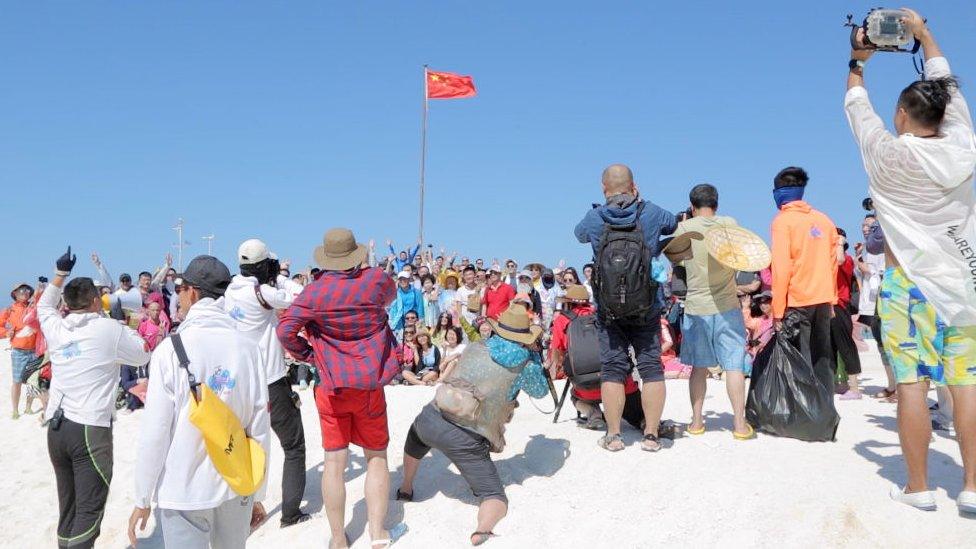
Chinese tourists in front of a Chinese flag on the Paracel Islands
The South China Sea is critical, for example, for the future success of China's Greater Bay Area economic development plan, into which Hong Kong is incorporated.
China's plan for populating the South China Sea was launched in 2012 when "Sansha City", the administrative centre for all Chinese-claimed features in the South China Sea on Woody Island in the Paracels, was upgraded from county to prefecture-level status.
The government re-settled the small fishing community there into modern dwellings, built a primary school, a bank and a hospital and installed mobile communications. Tourists have been visiting on regularly scheduled cruises to the islands.
The second phase of the plan was initiated in April this year, when China created two further county level administrative districts subordinate to Sansha City, including the establishment of Nansha District People's government, headquartered on Fiery Cross Reef and administering all the Chinese claimed features of the Spratly Islands.
In the six years since China began reclamation of several reefs and atolls in the Spratlys, satellite and air surveillance has revealed one of the world's greatest feats in maritime engineering and military construction.
In addition to the military facilities on the islands - including 3,000m runways, naval berths, hangars, reinforced ammunition bunkers, missile silos and radar sites - images show neatly arranged accommodation blocks, administrative buildings roofed with blue ceramic tiles, hospitals, and even sports complexes on the reclaimed islands, which have become visibly greener.
Subi reef is now home to a farm - including a six-acre fruit and vegetable plot pollinated by bees imported from the mainland, a herd of pigs, flocks of poultry and fish ponds.
Meanwhile, the China Academy of Sciences established an Oceanographic Research Centre on Mischief Reef in January 2019.
China's top hydrologists have announced that the water table on Fiery Cross - once little more than a rock in the sea - has been expanding rapidly and will allow water self-sufficiency within 15 years (link in Chinese), external.
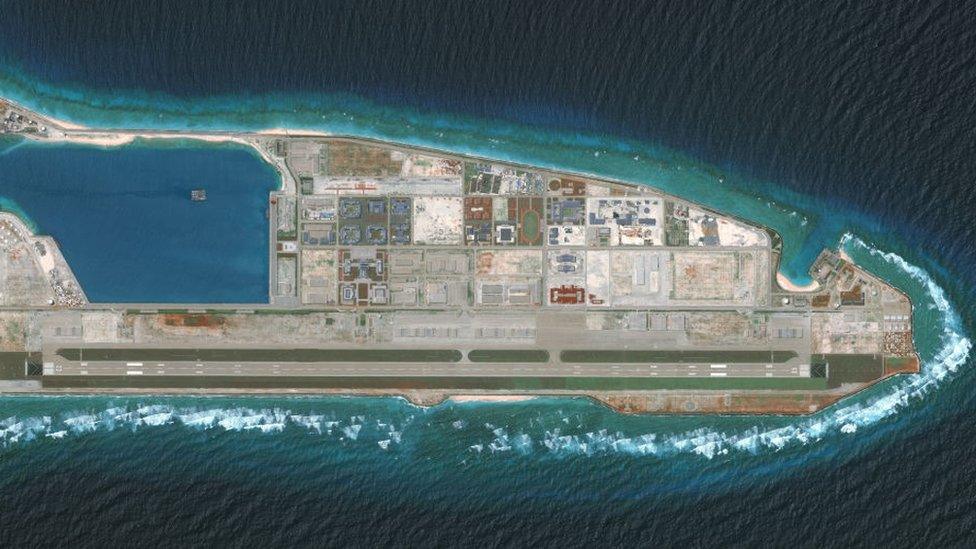
An overview of the Fiery Cross Reef
The residents of the island already enjoy 5G mobile data access and availability of fresh fruit and vegetables shipped in refrigerated containers.
Imagery also shows large fishing fleets moored in the larger lagoons on Subi and Mischief reef.
Perhaps before too long, fishing families could be permanently housed on China's southernmost islands, their children schooled alongside those of party and government officials.
An 'irreversibly' Chinese waterway?
The most symbolic evidence of China's push into the South China Sea is quite literally set in stone - transplanted from mainland China.
In April 2018, 200-tonne commemorative megaliths, erected on each of the three biggest island bases in the Spratly Islands were unveiled amid some secrecy.
Quarried from Taishan stone and shipped to the Spratly islands, the monuments resonate with President Xi Jinping's China Dream of national rejuvenation.
Mount Taishan is viewed as the most sacred of China's mountains, a symbol of unbroken Chinese civilisation for thousands of years.
All of this shows China has moved into a second phase of a calculated plan to make this great strategic waterway of South East Asia an irreversibly Chinese one.
The recent US Navy exercises in the South China Sea were aimed at demonstrating US resolve to protect the "freedom of the seas": for the US Navy to operate in and ultimately protect the seaspace across these international waters.
Alongside the US Naval manoeuvres, Mr Pompeo's announcement formally stating that China's claims across the region are "completely unlawful" begs the question of what the US is prepared to do next.
At a minimum, Mr Pompeo wants to build a diplomatic coalition to demonstrate China's self-isolation, not just with some of the other claimants but also along with bigger powers.
The US could very rapidly reduce China's new Nansha district to concrete and coral rubble - but this would entail a war for which neither the US nor China has an appetite.
Alexander Neill is a military analyst and director of a strategic advisory consultancy in Singapore
- Published14 July 2020
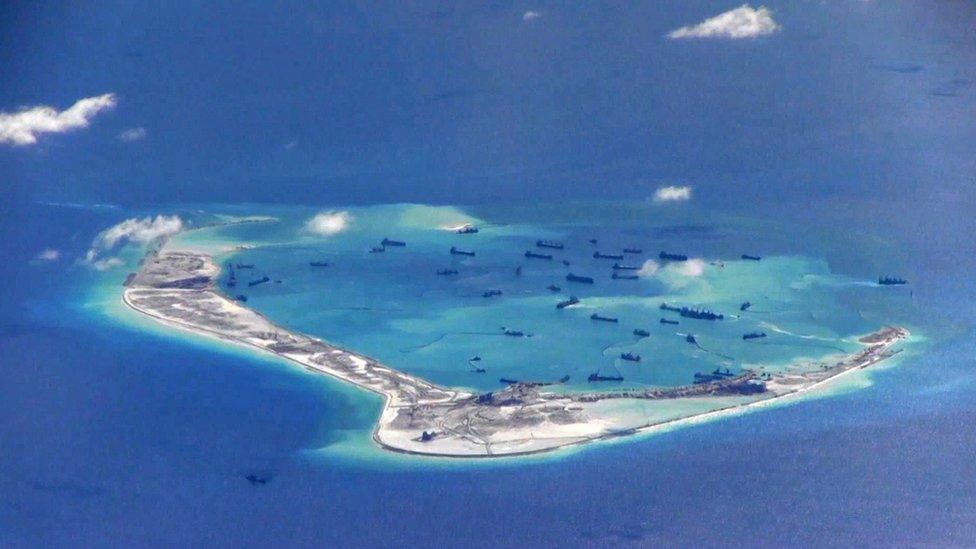
- Published11 July 2016
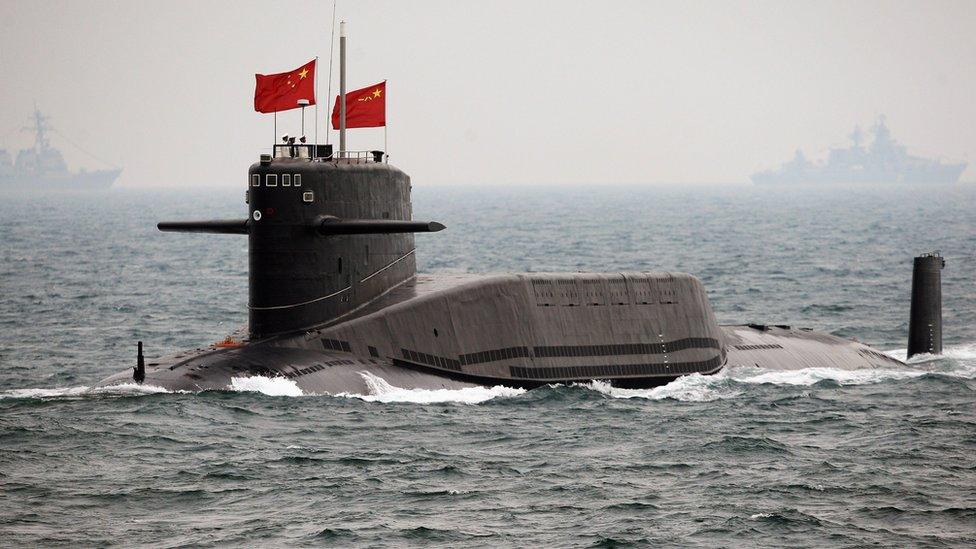
- Published11 August 2018
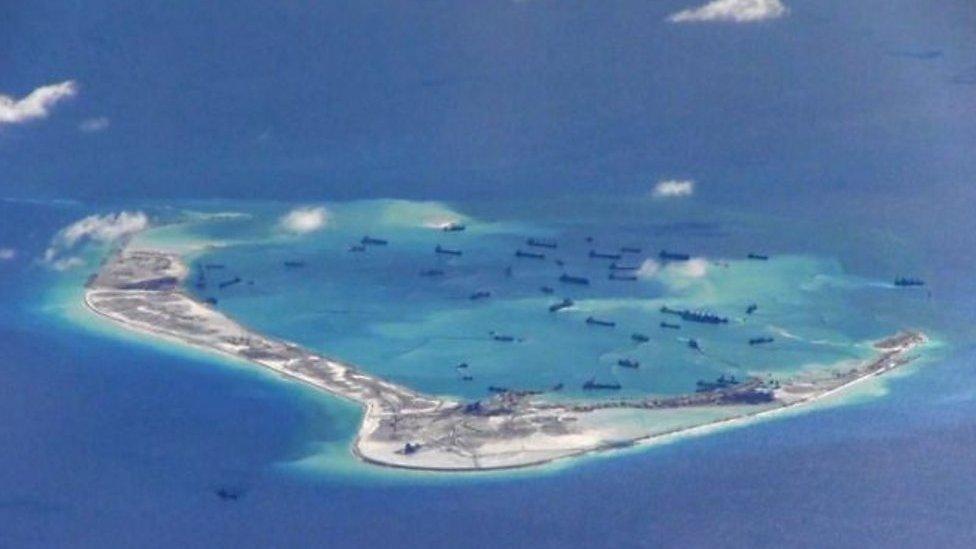
- Published7 July 2023
